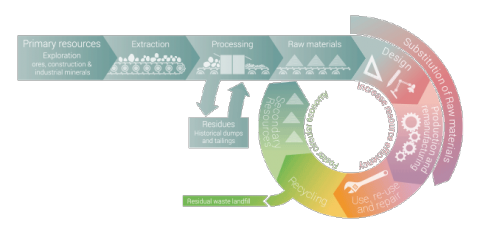ERA-NET Confund on Raw Materials (ERA-MIN) is a global, innovative and flexible pan-European network of research funding organisations, supported by EU Horizon 2020, that counts now with its third edition, ERA-MIN3 (2020-2025) and builds on the experience of the FP7 ERA-NET ERA-MIN (2011-2015) and the still running ERA-MIN 2 (2016-2022).
ERA-MIN aims to support the European Innovation Partnership on Raw Materials (EIP RM), the EU Raw Materials Initiative and further develop the raw materials (RM) sector in Europe through funding of transnational research and innovation (R&I) activities. This will be achieved through calls designed and developed specifically for the non-fuel, non-food raw materials sector.
ERA-MIN3: RAW MATERIALS FOR THE SUSTAINABLE DEVELOPMENT AND THE CIRCULAR ECONOMY aims to improve synergy, coordination and coherence between regional, national and EU funding in the raw materials sector by reducing fragmentation of raw materials funding across Europe and globally, as well as, improving the use of human and financial resources, the competitiveness and the environmental, social, health and safety issues of raw materials operations through supporting of transnational, excellent and translational R&I activities. It is built on the success of ERA-MIN 2: RESEARCH & INNOVATION PROGRAMME ON RAW MATERIALS TO FOSTER CIRCULAR ECONOMY, which is still running. Successively, ERA-MIN2 is built on the experience of ERA-MIN (2011-2015) whose aim was to bring together a significant number of funding and programming organisations to support the development of the non-energy mineral raw materials research area in Europe.

Partners
LATEST NEWS

Lithium is the essential element for the batteries of our hashtag electric vehicles and for our energy storage. Europe has enough hashtag#lithium in its bedrock to become self-sufficient. But today there is no operational mine yet, and the EU is depending on imports from China. A new responsible way of mining is necessary, one that recognises the importance of local and cultural preservation. Can the European Union lead the way?
Upcoming Events

WORLD RESOURCES FORUM 2025
A global multi-stakeholder platform for innovative resource solutions: Shaping Resource Strategies for a Sustainable Future.
The use and governance of natural resources lies at the core of today’s most pressing challenges – from the triple planetary crisis to social inequality and economic development. The way we use natural resources impacts not only global sustainability but also the fairness and resilience of societies worldwide. To tackle these complex, interdependent issues, innovative and inclusive strategies are urgently needed.

We are delighted to invite you to join the 9th MINEX Europe Mining & Exploration Forum taking place on 21-23 October 2025 in Libson, Portugal . Optional visits will be organised on 30 October to the local mine sites.
The Forum is organised under the slogan “Made in Europe”: Securing Metals and Minerals for a Sustainable Future”.
The agenda emphases on increasing domestic production, enhancing recycling efforts, and securing sustainable supply chains for critical minerals essential to Europe’s green and digital transition.



























